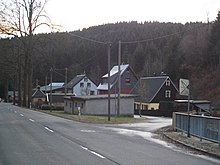Siebenhöfen (Tannenberg)
|
Siebenhöfen
Community Tannenberg
Coordinates: 50 ° 36 ′ 55 ″ N , 12 ° 55 ′ 50 ″ E
|
||
|---|---|---|
| Postal code : | 09468 | |
| Area code : | 03733 | |
|
Location of Siebenhöfen in Saxony |
||
Siebenhöfen is the only part of the municipality of Tannenberg in the Saxon Erzgebirgskreis .
geography
location
Siebenhöfen is located 2.5 kilometers northwest of the center of Tannenberg. On the other hand, the town seamlessly connects to the development of the city of Geyer in the south. Siebenhöfen is located in the Middle Ore Mountains on the Geyerbach , which flows into the Zschopau in Tannenberg . The Geyersche Binge is located directly north of Siebenhöfen.
history
The Siebenhöfen settlement in the Geyerbach valley between the mountain town of Geyer in the north and the village of Tannenberg in the southeast belonged to the manor of the Tannenberg manor as early as 1696 , where it remained until the 19th century. Although Siebenhöfen has always belonged to Tannenberg, it was more likely to belong to the mining town of Geyer in terms of mining. The smelting works and stamping works of Geyer's mining industry stretched down the valley to Siebenhöfen and shaped the townscape until the 18th century. The ore extracted from nearby Geyersberg was processed in them. The “Pochwerkgasse” is still a reminder of this time. In 1716 Siebenhöfen consisted of five small estates and two cottages.
The industrialization of Siebenhöf began in the early 19th century. On August 14, 1812, the British spinning master and mechanical engineer Evan Evans , who is also considered the founder of industrial cotton spinning in Saxony, bought the Hohneujahrer and Oberen Neidhardter smelting works and stamp mills for 300 talers from the Zwitterstock trade union in Geyer . At this point he began building his own cotton spinning mill , for which the Chemnitz industrial master builder Johann Traugott Lohse provided the construction plans. At the time, it was the largest factory building in Saxony. After the factory in Siebenhöfen started operations, Evans sold it to his wife in 1814. Evan Evans devoted himself primarily to the construction of the spinning technology, for which he had acquired the Zainhammer in Tannenberg. After the death of Evan Evans' wife, their son Eli Evans (1805–1882) took over the company in 1838. His students further developed the technology of the textile industry in Saxony. In 1878 Evans sold the spinning mill to Karl F. Fichtner. With the opening of the Schönfeld-Wiesa-Meinersdorf narrow-gauge railway , the factory right next to the Siebenhöfen stop was given the opportunity in 1888 to load its products onto rail wagons with a branch track and loading pit. The Evans spinning mill in Siebenhöfen burned down in 1896, during the reconstruction, due to the demolition of entire building sections and redesigns, such as the removal of the mansard roof , much of Lohse's original architecture was lost. The building was still used as a warehouse until 1990, and the listed building has been empty since then. On August 17, 1967, with the cessation of rail traffic on the narrow-gauge railway, the Siebenhöfen stop was also closed.
Siebenhöfen belonged as part of Tannenberg until 1856 to the electoral or royal Saxon office of Selva Val Gardena. From 1856 on, Tannenberg and the Siebenhöfen district belonged to the Geyer court office and from 1875 to the Annaberg administration . As a result of the second district reform in the GDR , the municipality of Tannenberg with its Siebenhöfen district became part of Annaberg in the Chemnitz district (renamed Karl-Marx-Stadt district in 1953 ), which was continued as the Saxon district of Annaberg from 1990 and was added to the Erzgebirgskreis in 2008 .
Personalities
- Eli Evans (1805–1882), son of Evan Evans, entrepreneur and politician
- Evan Evans (1765–1844), British master spinner and mechanical engineer. He is considered to be the founder of industrial cotton spinning in Saxony .
Web links
- Siebenhöfen in the Digital Historical Directory of Saxony
- Festschrift for the local anniversary of the municipality of Tannenberg
Individual evidence
- ↑ The Tannenberg Manor at www.sachsens-schlösser.de
- ↑ The Geyerschen Pochwerke on the website of the Geyer – Tannenberg culture mile
- ^ Tannenberg with Siebenhöfen in the "Handbuch der Geographie", pp. 304f.
- ↑ The Zainhammer Tannenberg on the website of the Geyer-Tannenberg culture mile
- ↑ The Evans factory at www.industrie-kultur-ost.de
- ↑ The Evans factory on the website of the Geyer – Tannenberg cultural mile
- ↑ The Siebenhöfen stop on www.sachsenschiene.net
- ^ Karlheinz Blaschke , Uwe Ulrich Jäschke : Kursächsischer Ämteratlas. Leipzig 2009, ISBN 978-3-937386-14-0 ; P. 68 f.
- ^ The official authority Annaberg in the municipal register 1900




